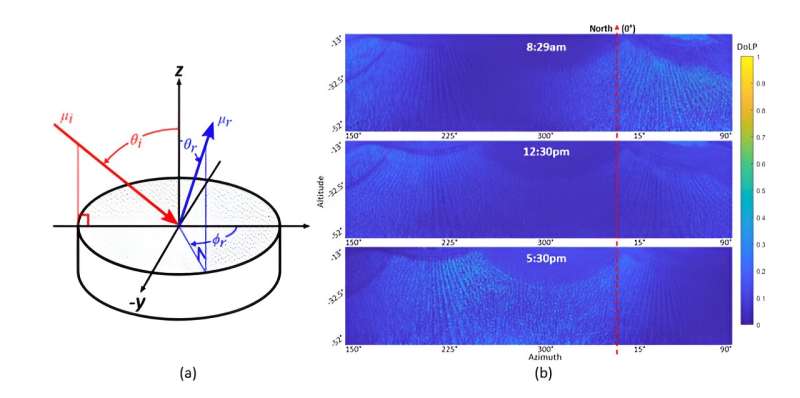This article has been reviewed according to Science X's editorial process and policies. Editors have highlighted the following attributes while ensuring the content's credibility:
fact-checked
trusted source
proofread
Enhancing field phenotyping: A novel glare correction technique using polarized light

Amidst challenges like a booming global population and diminishing arable land, plant phenotyping offers a way to automate agriculture and improve crop diagnostics. However, translating the precision of controlled-environment phenotyping to field conditions remains a hurdle, particularly in accurately measuring leaf color due to sunlight glare. Existing solutions, ranging from light scattering simulations to 3D sensor fusion, often require complex, time-consuming, or impractical methods.
In March 2024, Plant Phenomics published research titled "Mitigating Illumination-, Leaf-, and View-Angle Dependencies in Hyperspectral Imaging Using Polarimetry." This research aims to develop a novel, single-frame glare color correction technique utilizing polarized BRDF models and polarization-sensitive measurements, potentially revolutionizing field phenotyping by addressing the persistent challenge of glare without the need for complex or time-intensive methods.
Initially, pBRDF measurements were performed on two B73 maize plants using SCATMECH models at a wavelength of 550nm, which provided the basis for the creation of a generalized library of mmBRDF models for maize leaves.
This foundational step was followed by correction model simulations, where the model processed uncorrected reflectivities and Stokes parameters and showed that increasing polarization led to a decrease in the perceived value of the parameter γ. This suggested a potential for correcting high DoLP and erroneous γ values despite challenges in areas of retroreflection.
Validation of this correction model involved spectral ground truth measurements across a field and comparison between corrected and uncorrected Regions of Interest (ROIs) from low and high DoLP areas. This process confirmed the uniformity of plant behavior across the field and over time, supporting the assumption of the model.
The field trial data also showed that images taken at different times of day varied in their degree of polarization, with the correction model significantly reducing the mean square error (MSE) and standard deviation of the calculated indices, GNDVI and RERR, by significant factors.
The performance of the model was visually and statistically validated using spectropolarimetric image data from a field trial, showing a significant improvement in the accuracy of phenotypic imaging under varying conditions. The error and variance of the image data were significantly reduced, confirming the spectral invariance hypothesis and suggesting the potential applicability of the correction network across different two-band metrics.
The research concluded with promising results, indicating that polarimetry could play a crucial role in enhancing the capabilities of multi- and hyperspectral sensor systems for high-throughput phenotyping applications in the field. Future work will focus on extending the model to different maize varieties, assessing the impact of varying weather conditions, and expanding the library of mmBRDF and correction models for broader agricultural applications.
More information: Daniel Krafft et al, Mitigating Illumination-, Leaf-, and View-Angle Dependencies in Hyperspectral Imaging Using Polarimetry, Plant Phenomics (2024). DOI: 10.34133/plantphenomics.0157
Provided by NanJing Agricultural University





















